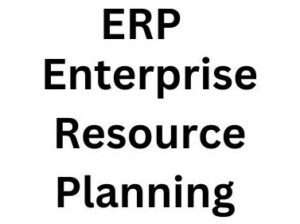Enterprise Resource Planning (ERP) is a system that integrates all the essential business processes of an organization, such as accounting, manufacturing, sales, and human resources.
ERP systems can help businesses to improve their efficiency, productivity, and profitability. They can also help businesses to make better decisions by providing them with real-time data and insights.
What Is Full Form OF ERP?



The full form of ERP is Enterprise Resource Planning. It is a system that integrates all the essential business processes of an organization, such as accounting, manufacturing, sales, and human resources. ERP systems help businesses to improve their efficiency, productivity, and profitability. ERP systems are typically implemented as a software suite that can be customized to meet the specific needs of an organization. They can be hosted on-premises or in the cloud.
If you are considering implementing an ERP system, there are a few things you should keep in mind:
- The size of your organization: ERP systems can be complex and expensive to implement. If you have a small business, you may want to consider a smaller, less complex system.
- The industry you are in: Some ERP systems are designed for specific industries, such as manufacturing or retail. If you are in a specialized industry, you may want to choose an ERP system that is specifically designed for your industry.
- Your budget: ERP systems can range in price from a few thousand dollars to millions of dollars. You need to make sure that you choose a system that fits your budget.
ERP classifications
ERP Classification | Description |
|---|---|
| On-premises | On-premises ERP systems are installed and hosted on-site at the organization’s own data center. This type of system offers the highest level of control and security, but it can be more expensive to implement and maintain. |
| Cloud-based | Cloud-based ERP systems are hosted and maintained by a third-party vendor. This type of system is more scalable and easier to implement, but it may offer less control and security than an on-premises system. |
| Hybrid | Hybrid ERP systems combine the features of on-premises and cloud-based systems. This type of system offers the best of both worlds, but it can be more complex to implement and manage. |
| Generic | Generic ERP systems are designed to be used by businesses of all sizes and industries. This type of system is more flexible and customizable than a specialized system, but it may not offer the same level of functionality. |
| Specialized | Specialized ERP systems are designed for specific industries, such as manufacturing, retail, or healthcare. This type of system offers the most functionality and integration for a particular industry, but it may be more expensive and less flexible than a generic system. |
Benefits of ERP Systems
Some of the benefits of ERP systems include:
- Improved efficiency: ERP systems can help businesses to streamline their operations and reduce manual data entry. This can lead to significant time and cost savings.
- Increased productivity: ERP systems can help businesses to make better decisions by providing them with real-time data and insights. This can lead to improved productivity and profitability.
- Enhanced visibility: ERP systems can help businesses to get a better understanding of their operations. This can help them to identify areas where they can improve and make better decisions.
- Improved compliance: ERP systems can help businesses to comply with government regulations. This can help them to avoid costly fines and penalties.
ERP's Drawbacks
Drawback | Description |
|---|---|
| Cost | Implementing ERP systems can be expensive, including software licenses, hardware upgrades, and ongoing maintenance. |
| Complexity | ERP systems can be complex to implement and require significant planning and coordination. |
| Customization | Customizing ERP systems to meet specific needs can be time-consuming and costly. |
| Implementation Time | ERP implementation can be time-consuming, leading to operational disruptions during the transition. |
| User Resistance | Employees may resist using the new ERP system due to its complexity or changes in established workflows. |
| Data Migration | Transferring data from legacy systems to the ERP can be tricky, leading to data migration issues and quality problems. |
| Training and Skills | Training employees to use the ERP effectively requires time and effort. |
| Dependence on Vendor | Companies become reliant on the ERP vendor for support, updates, and enhancements, leading to vendor lock-in. |
| Continuous Maintenance | ERP systems need ongoing maintenance, updates, and improvements, adding to the overall cost and complexity. |
| Scalability | Some ERP systems may not scale well with rapid business growth or changes in organizational structure. |
Frequently Asked Question
The full form of ERP is Enterprise Resource Planning. It is a system that integrates all the essential business processes of an organization, such as accounting, manufacturing, sales, and human resources.
It is a software system that integrates all the essential business processes of an organization, such as accounting, manufacturing, sales, and human resources.
The ERP life cycle is a series of stages that an ERP system goes through, from its initial conception to its eventual retirement. The stages of the ERP life cycle typically include initiation, planning, implementation, deployment, operational, maintenance, and retirement.






